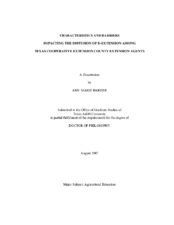| dc.contributor.advisor | Lindner, James R. | |
| dc.creator | Harder, Amy Marie | |
| dc.date.accessioned | 2010-01-14T23:56:52Z | |
| dc.date.accessioned | 2010-01-16T01:44:19Z | |
| dc.date.available | 2010-01-14T23:56:52Z | |
| dc.date.available | 2010-01-16T01:44:19Z | |
| dc.date.created | 2007-08 | |
| dc.date.issued | 2009-05-15 | |
| dc.identifier.uri | https://hdl.handle.net/1969.1/ETD-TAMU-1408 | |
| dc.description.abstract | The overall purpose of this study was to understand the influence of selected
factors on the adoption of eXtension by Texas Cooperative Extension County Extension
agents. Specifically, the study looked at how the relationships between stage in the
innovation-decision process, characteristics of agents, characteristics of the innovation,
and barriers to adoption affect the diffusion of eXtension. A random sample of 237
agents was selected for participation in the study. A majority of agents reported they
were in the knowledge stage (52%); 31% had no knowledge of the innovation; 8% were
in the implementation stage; 3% were in the persuasion stage; 3% were in the decision
stage and 2% were in the confirmation stage.
Respondents had positive perceptions of relative advantage, compatibility,
complexity and trialability as those characteristics related to eXtension. They had the
most positive perceptions of complexity. They did not perceive eXtension to have a high
degree of observability. Agents perceived at least five barriers existed to the adoption of eXtension.
Reducing or eliminating these barriers, particularly the barrier related to concerns about
time, would be expected to positively affect the rate of adoption.
Agents’ perceptions of complexity and compatibility significantly differed by
primary agent role and gender, respectively. The differences may be attributable to
varying job experiences based upon role and gender.
Agents’ perceptions of a lack of eXtension incentives significantly differed by
education. Significant relationships existed between selected characteristics of eXtension
and potential barriers to the adoption of eXtension. Based on the findings, offering
monetary incentives may increase the rate of adoption, and decrease agents’ financial
concerns.
Significantly more respondents reported they were in the “no knowledge” stage
in the innovation-decision than would be expected to occur by chance.
Agents may have ignored repeated messages about eXtension because it was not
perceived as consistent with their attitudes and beliefs. This implication should be noted
by those hoping to increase the diffusion of eXtension.
On a broader level, these findings support expanding the model of the
innovation-decision process to include the “no knowledge” stage. | en |
| dc.format.medium | electronic | en |
| dc.format.mimetype | application/pdf | |
| dc.language.iso | en_US | |
| dc.subject | Cooperative Extension | en |
| dc.subject | E-Extension | en |
| dc.title | Characteristics and barriers impacting the diffusion of e-extension among Texas Cooperative Extension County Extension agents | en |
| dc.type | Book | en |
| dc.type | Thesis | en |
| thesis.degree.department | Agricultural Leadership, Education, and Communications | en |
| thesis.degree.discipline | Agricultural Education | en |
| thesis.degree.grantor | Texas A&M University | en |
| thesis.degree.name | Doctor of Philosophy | en |
| thesis.degree.level | Doctoral | en |
| dc.contributor.committeeMember | Dooley, Larry M. | |
| dc.contributor.committeeMember | Murphy, Tim H. | |
| dc.contributor.committeeMember | Stedman, Nicole L.P. | |
| dc.contributor.committeeMember | Wingenbach, Gary J. | |
| dc.type.genre | Electronic Dissertation | en |
| dc.type.material | text | en |
| dc.format.digitalOrigin | born digital | en |


